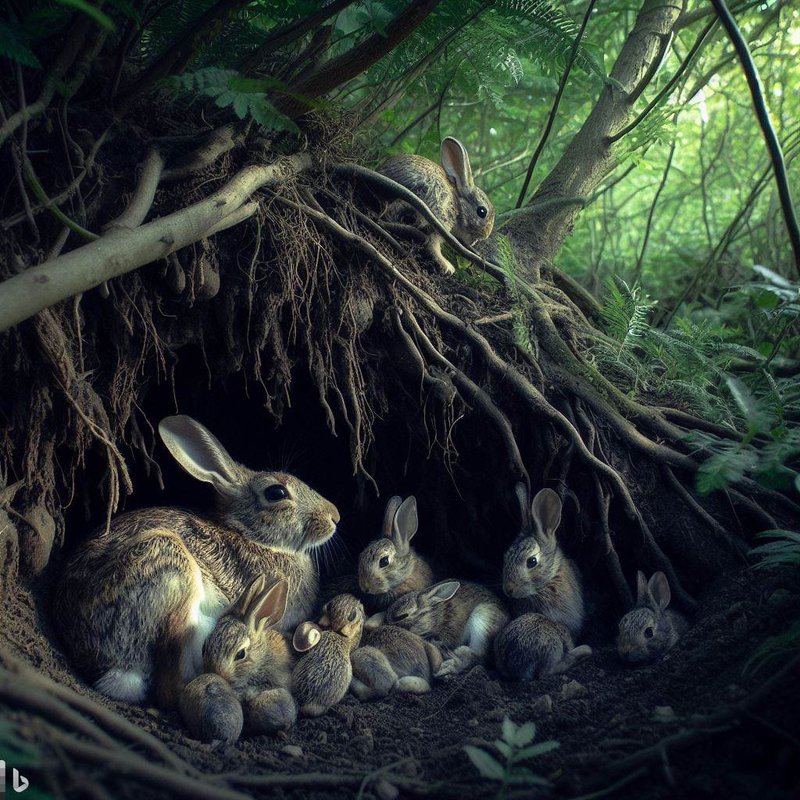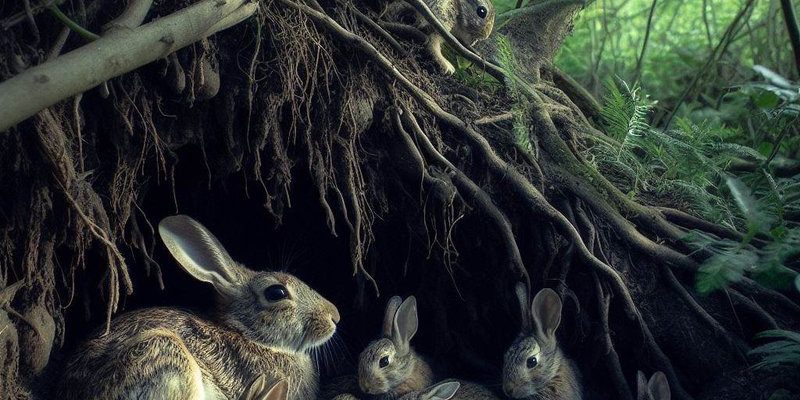
In the wild, rabbits face numerous challenges, from predators to finding food. Despite these hurdles, their parenting style is both instinctual and highly effective. Let’s dive into how these adorable animals manage to raise their young and what makes their approach so special.
The Nest: A Safe Haven for Kits
When a rabbit is ready to give birth, she instinctively digs a nest. This is no casual digging; it’s a carefully considered location. The nest is often placed in a sheltered spot, away from prying eyes, to help protect the kits from predators. It’s usually made of grass, fur pulled from the doe’s belly, and any leaves she can find. This cozy little chamber helps keep the kits warm and safe.
Once the nest is ready, the doe will give birth to a litter—usually between three to twelve kits. Can you imagine being surrounded by that many tiny, wiggly rabbits? The kits are born blind and hairless, relying entirely on their mother for warmth and nourishment. This might sound a bit daunting, but here’s the thing: rabbits have evolved to manage these challenges beautifully.
Feeding the Kits: Nature’s Way
Rabbits are known for their ability to reproduce quickly, and part of that is how they feed their young. After giving birth, the mother will nurse the kits only once or twice a day. Surprising, right? But there’s a solid reason behind this! Nursing too often could attract predators. By keeping nursing sessions short and infrequent, the doe reduces the risk of being spotted by wandering eyes.
The milk from a rabbit is rich in nutrients, perfect for those growing kits. As they start to grow and gain fur, they’ll begin to nibble on solid food, like grass and clover. This transition is essential; it teaches them to forage for food themselves, setting them up for survival once they leave the nest. Honestly, the way mother rabbits manage both safety and nourishment is quite impressive.
Instincts and Independence: A Quick Learning Curve
You might be wondering how quickly these little rabbits learn to fend for themselves. Kits grow remarkably fast, gaining their eyesight and fur within a few weeks. They start to hop around the nest and explore their surroundings. Isn’t it amazing how nature works?
The doe will encourage independence by spending less time in the nest as the kits mature. She’s not just disappearing; she’s teaching them that they need to be self-sufficient. As they venture out, the doe keeps a watchful eye, ensuring they learn to recognize dangers while exploring their environment. It’s a delicate balance of nurturing and letting go.
Paw-tioning Danger: How Mother Rabbits Protect Their Young
Survival in the wild is tough, and rabbits face many threats, including foxes, hawks, and even domestic pets. Mother rabbits have a few tricks up their sleeves to protect their young. For starters, if she senses danger, the doe often pretends to be injured or sick to lure predators away from her kits. It’s a tough act, but one that can save lives.
Additionally, the mother will do her best to camouflage her nest, covering it with grass or foliage. Even the smell of the kits is masked by the mother’s fur. This ensures that predators are less likely to discover their hiding spot. It’s all about survival, and the doe’s instincts kick in to ensure her little ones have the best chance possible.
The Role of the Environment: A Rabbit’s Habitat
Rabbits thrive in different environments, from forests to grasslands and even urban areas. Their choice of habitat plays a crucial role in how they raise their young. For instance, in more open areas, they might dig deeper burrows to keep their kits hidden. In densely wooded regions, they can find plenty of materials for building snug nests.
You might be surprised to learn that the local ecosystem also affects rabbit populations. In times of abundance, they reproduce in higher numbers, ensuring that even if some young don’t survive, others will. It’s a natural balance that ensures these adorable creatures continue to thrive, even when conditions aren’t perfect.
The Life Cycle: From Kits to Adult Rabbits
As the kits reach about eight weeks old, they’re ready to venture into the bigger world. It’s both a joyous and bittersweet moment for their mother. The doe may continue to care for them, but she’s also preparing for the next litter. Remember, rabbits are known for their fast reproduction rates and can have several litters each season.
Once they leave the nest, the young rabbits face a new set of challenges. They must navigate the wild, learn how to find food, and avoid predators. But the skills they learned from their mother, combined with their natural instincts, prepare them well for this next chapter in life. It’s all part of the amazing cycle of life in the wild.
Rabbits are truly remarkable in how they raise their young. From building safe nests to balancing nurturing with independence, mother rabbits possess an instinctive knowledge that allows their kits to survive and thrive in the wild. Their ability to adapt to their environment, protect their young, and teach them essential survival skills showcases the wonders of nature.
Watching rabbits care for their offspring not only brings joy but also reminds us of the delicate balance of life in the animal kingdom. Next time you see a rabbit, take a moment to appreciate the hard work and dedication that goes into raising those little ones. It’s a heartwarming glimpse into the wild that we often take for granted.

